Fatehpur Sikri is a UNESCO World Heritage Site, located about 40 kms from Agra in Uttar Pradesh. It has a very interesting history of its evolution and then a sudden devolution. It was a dream project of Mughal Emperor Akbar The Great. He built this impressive city in so many years and suddenly one day abandoned it for some inexplicable reason. Akbar shifted his capital from Agra to Fatehpur Sikri, then to Lahore and again came back to Agra. Capital city changed, but charm of Fatehpur Sikri always lured its admirers for the coming years.
Today, Fatehpur Sikri is a small town away from the limelight, but its royal complexes of Mughal Era give its a distinct place at the tourist map. The whole area of World Heritage Site has three distinct complexes. First, The Mosque Complex at the highest level, comprises a Dargah (Tomb) of Shiekh Salim Chisti with Jami Mosque and a lofty gateway known as Buland Darwaja; second, The Royal Complex consists the royal enclosures of the palaces, the harems and official buildings of Emperor Akbar and the third one, The Public Complex, at the lowest level, comprises Panch Mahal, Khwabgah, Anup Talao, Diwan-i-Aam etc. You can refer two earlier posts to have a good idea on various ways to reach Fatehpur Sikri, Buland Darwaja, Sheikh Salim Chisti Dargah and an impressive building called Turkish Sulatana’s House in the royal premises. Present post is about the Royal Complex and some part of the Public Complex, covers ticket pricing details and attractions like Lower Haramsara, Birbal’s House, Jodha Bai’s Palace, Mariam’s Palace, Panch Mahal and Diwan-i-Khas. The next post will cover other attractions of The Public Complex that include Anup Talao, Diwan-i-Am, Mint, Treasury, Naubatkhana etc..

We entered in the section of royal enclosures through the King’s Gate (Badshahi Darwaja) located in the complex of Buland Darwaja. After walking for about 300 meters we came across a ticket counter.
Ticket Price: For Indians and The nationals of SAARC countries (Bangladesh, Nepal, Bhutan, SriLanka, Afghanistan, Maldives, Pakistan, also including Thailand and Myanmar, all with their identity card), the ticket price is INR 10 to visit the entire complex. For other Foreign Nationals, the ticket price is INR 250. Entry for the children, below the age of 15 years, are free irrespective of their nationality. Digital Cameras and Tripods are allowed inside the royal enclosure without any charge. For videography, a separate ticket of INR 25 is required. Wheel-chair facility is also available for handicapped person.
Tourist Guides: Official tourist guides are available near the ticket counter and as soon as we bought our tickets, they started chasing us. I did not want to hire a guide, so informed them that I wanted to explore the entire complex on my own pace. The guide charge is varying from INR 250 to INR 500 depending on the group size upto 35 persons. For more than 35 people, you have to again hire a separate guide for the excess person and so on.. There is an official display of these charges, but sometimes, if there is less tourists, a guide may offer his services at less than the mentioned rate to make some money that day.
After buying our tickets, we walked inside the royal enclosure, through a narrow path covered by the beautiful flowers on both the side. The first stop was camel stable or lower haramsara.

Lower Haramsara: In a first glance it looks like a long corridor with a large colonnade constructed with beautiful red stone. The numerous large semi-circular stone rings gave an idea that they might had been used to fetter the horses, camels and even elephants. Thus, this corridor was used as a camel or a horse stable.
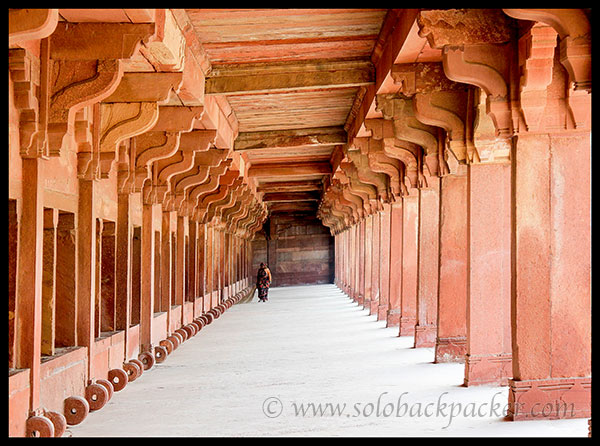
But its closeness to the Birbal’s Palace and Jodha Bai’s Palace contradicted this theory. It might had been used for the housing purpose of service-maids of the royal harem and those stone rings were used for partitioning in the space by fixing curtains. This is the main reason behind its name as Lower Haramsara.
Birbal’s Palace: Adjacent to Camel Stable, there is a double-storey building raised on pillars and arches of plain masonry, standing on a large concrete platform. This building was used by Birbal for residential purpose. There are lot of folk stories about the intelligence of Birbal, that often tested by The Emperor Akbar. Birbal always made the Emperor unanswered by his intelligence and became very dearer to him. So, Akbar gave him a palace in the royal enclosure of Fatehpur Sikri. The floral designs, carved eaves and wonderful geometrical patterns make this palace outstanding.

But, its closeness to the palaces of queens creates a confusion. This palace was surrounded by Lower Haramsara, Jodha Bai’s Palace and Mariam’s Palace. It means that part of the royal enclosure was generally used by royal ladies and their service-maids. So why did Akbar build a palace for Birbal in that part ? Many believe that Birbal’s Palace was originally built for a royal queen, but she was not happy with its architecture and design. Thus, Akbar modified that palace and gifted to Birbal for his residential use.
Adjacent to Birbal’s Palace, there is a good viewpoint to see the backdrop of the royal enclosure. In the winter season, the yellow mustard in the fields around the royal enclosure make the whole place very scenic and mesmerizing.

Jodha Bai’s Kitchen: Moving away from Birbal’s Palace and after passing some not so special buildings we came across the kitchen of Jodha Bai. Now a separate part in a corner, it may have been an annexe of the haramsara. The cloisters joining it is not survived now. Its sloping roof has been subsequently replaced by a flat roof. The outer walls of this kitchen are carved with floral and geometric patterns and band of jhumkas (ear-ornaments).
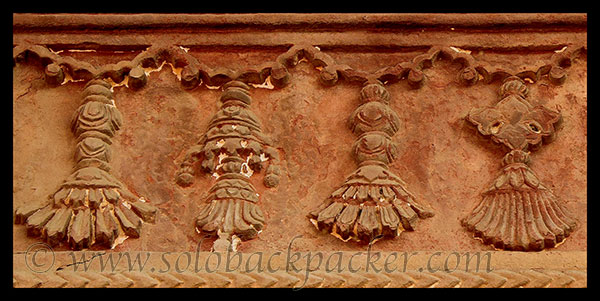
Jodha Bai’s Palace: In front of the kitchen, a big entrance is leading to the palace of Jodha Bai. The largest and most important palace of Fatehpur Sikri was basically used as the main haram of the Emperor Akbar. Then why this name Jodha Bai’s Palace? People think that this palace was the official residence of Akbar’s favourite queen Jodha Bai. Hence this name Jodha Bai’s Palace came into existence. But who was Jodha Bai? There are no clear answer on this. All historians believed that Akbar married with the daughter (famous a Jodha Bai in the stories) of the Mewar Ruler King Bharmal, but nobody knew her name. Whatever was her name, but she was definitely not Jodha Bai. There is a strong belief that Jodha Bai could be the grand-daughter of Akbar and wife of Jahangir as mentioned in some historical books. But nowhere, except Bollywood movies, it is mentioned that Jodha Bai was the wife of Mughal Emperor Akbar.
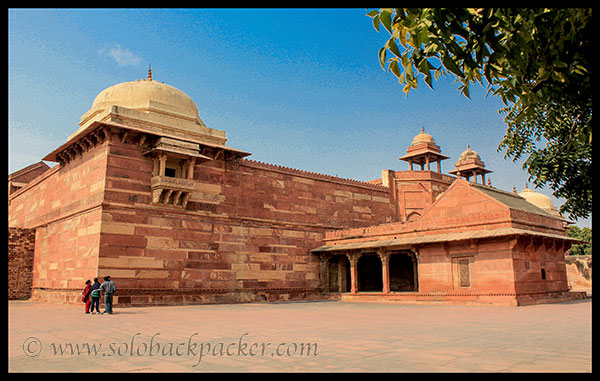
So this palace was not associated with Jodha Bai and it was only the main haram of the Emperor Akbar. It is most beautiful of all the royal edifices. The blue gazed tiles on the roof of this palace look impressive. On a side of the large courtyard of this palace, there is a small shrine supported on richly carved pillars. The shrine has niches for keeping the images of Hindu Deities and a platform to keep the principal deity. This shrine shows the Hindu connection of this palace and also a good example of Deena-E-Elahi concept of Akbar.

Mariam’s Palace: Coming out of the palace of Jodha Bai, we moved towards Mariam’s Palace, adjacent to the kitchen of Jodha Bai. It is also a residential building of Royal Enclosure and designated as Sunahara Makan, because of the numerous paintings and murals inscripted on the wall of this building. They are some paintings related to Lord Rama and Hanuman and also the band of lion heads, but they are not in very good condition. To sight them properly, either you can hire a tourist guide, or you have to really search in a hard way.
Who was Mariam? Mariam-uz-Zamani was one of the wife of Akbar and may be the mother of Jahangir. There is no historical evidence of the name Jodha Bai, so historians generally relate her with Mariam, but nobody know the exact truth.

Panch Mahal: Moving further from the Mariam’s Palace, we can enter in the Public Complex of Fatehpur Sikri, at the lowest level. Panch Mahal is located in the vicinity of Mariam’s Palace and basically a pleasure palace for the Emperor. It is a five-floored pillared pavilion entirely built on the pillars at each level and floor area are decreasing at every floor upwards. The top floor is just a kiosk supported on four slender pillars. The building contains 176 columns of which the ground floor has 84 columns, the first storey has 56, the second 20, the third 12 and the top storey has 4 columns. These columns are richly carved and provide interesting varieties of design and ornamentation.
It is also known as “Badgir”, means the wind tower. The open space between the pillars always worked as a great place to spend some time in the cool breeze. There is a huge courtyard and a pool in front of Panch Mahal. The courtyard and pool would have been the setting for musical concerts and other entertainment and The emperor and his queens are able to enjoy those programmes from Panch Mahal easily. There is a connecting corridor with jaalis (screen) from the third storey to the royal haram, through which the queens and princess could easily reach at the Panch Mahal, without coming in the notice of general public.
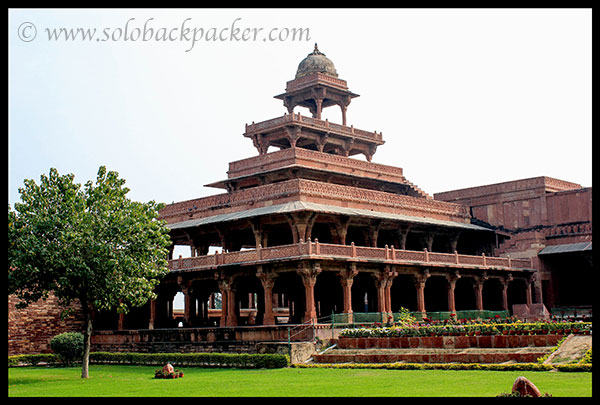
Diwan-i-Khas: After Panch Mahal, we reached at a large courtyard with many buildings and a pool scattered in that courtyard. Moving further, we reached to the Hall of Private Audiences, situated in a side of the courtyard opposite to the pool, near astrologers’ seat. From outside, it looks like a two-storey building, but inside it is only a single storey room in the middle of which a beautifully carved pillar raised upwards and supported by four diagonal galleries at some height. Some people believe that this hall is too small to accommodate the Emperor and all his ministers, so they believe that the hall might had been used for the purpose to store gems and precious stones. Some also believe that the hall might had been used for the purpose of weighing ceremony (Tuldana) for the emperor and the princess at the time of Persian new year.
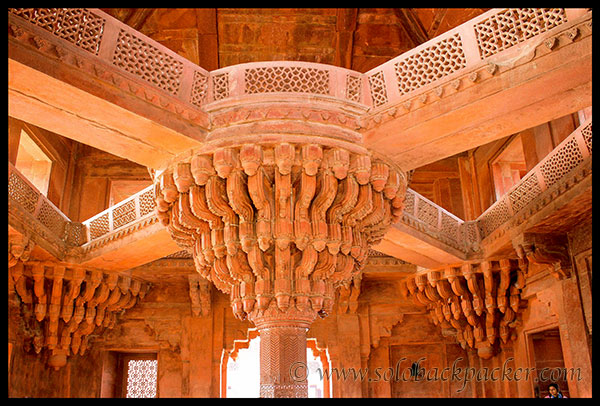

Astrologers Seat: Adjacent to Diwan-i-Khas, there is another building with three rooms, richly carved pillars, walls and arches. This building was used as a treasury room, and also known as Ankh Michauli (Blind’s Man Buff House). From the platform of the treasury, there rises a small elegant kiosk with some very good carving. This is known as Astrologer’s Seat and it is believed that a great Indian Yogi (Hermit) used to sit here and The Emperor Akbar used to consult him in big political matters. But, this is only a myth. Its closeness to the treasury suggest that this might had been used by the chief treasurer as his seat, while monitoring the activities of his subordinates.

There are many more attractions still left inside Public Complex, but it is better to split them in another part to keep this post interesting. Watch out for the coming posts for the other attractions inside the royal enclosure of Fatehpur Sikri.



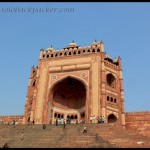
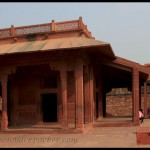



I did not explore Fatehpur skiri in so much details like you did. A – The weather was veryy veryyyyyy humid, so it was a turn off and very irritating to stay there for long. B- We did not have a SLR to cover the intricate carvings and study the palaces so closely. But the place is beautiful and is a great example of historical architecture! Loved this blog post of yours. Great job done Avinash.
Thank you so much for what you are doing ! I find your information and pictures wonderfully done ! I searched for your web site because you have taken a very nice picture inside of Mariam’s Palace (what I failed) ! Concerning Mariam Zamani, she is usually presented as a Christian wife of Akbar ! Yes, she was Cristian and she was Armenian. More than that she was the mother of Prince Jahandir. Historically it is interesting and important but politaccly to present a Christian as the mother of the next Emperer is not quite interesting. I like very much the film Jodha-Akbar. It is a very nice film which is surely politically oriented, a Muslim + an Hindu. But historically it is not true ! More that that Mariam uz Zamani was number 1 among all Moghol women for a se trade and there is an incident when her ship was seized by the Portuguese.
This love story between Indians and Armenians remind me of that of Prince William when his Armenian ancestor married an Indian woman and whose grandaughter arrived to GB to give an Indian-Armenian conncetion to Britans. The World is Small !
Thanks for your valuable and informative comment. 🙂 These days, I enjoy a serial (daily soap) titled Jodha Akbar, getting telecasted on Indian Television. Again far from reality, but concept is nice and it gives some nice information on the Moghul Empire of Akbar Era.
Nice post!
http://rajniranjandas.blogspot.in
I had missed going to Fatepur Sikri on our recent visit to Agra as we were short of time n it was a hot hot day. Thank u so much fr this virtual tour. Lovely pics esp the jhumka ones 🙂